
Kailash Manasarovar yatra was never in my mind…In fact I was not even aware of it. It all started when a friend of mine said that it was her dream to visit Manasarovar she even explained to me about the arduous journey and all the formalities. That was way back in the 90s and the thought just gradually faded away. In 2002 when I visited Amarnath the thought again occurred to me to visit Kailash but the cost, what I was told was exorbitant …a whooping one lakh!…I could just dream and watch videos of the yatra and do nothing else. The thought again left me….Then again in 2006 when on one of my night duties at the Chennai airport, say about 3:00AM when there was not much of an activity, I was having a casual talk to one of the Officers, Mr. Sridhar who happened to be a regular trekker, and was relating his experiences about Kailash. It was so interesting that I decided then that I should visit the place come what may. It was Mr. Sridhar who gave me all the details like where and when to apply and on his advise I went to the Office of Uttaranchal Tourism and gave my application with a copy of my passport. I was told about the selection process where the applications would be selected on a lottery basis and that it would take a couple of months and the chances depends on God’s wish.
The surprise came in the form of a telegram in the month of March, asking me to send a draft of Rs.5000 and to appear at the Heart & Lung Institute, New Delhi on the 14th of August 2007. I was quick to respond and I started taking things very seriously. As my weight was around 98 kgs, I had to trim my eating habits and get into regular exercises to keep myself fit for the journey. Once a month I took on to the General Motors Diet plan and that helped me in shedding some weight. My purchases were in a full swing getting the best trekking shoes, comfortable woollen clothes, eatables, extra batteries for my cameras and by the 12th of August I was ready to embark.
13th August 2007
With lots of dreams and fears, I woke up in the morning and visited the nearby Shiva temple where a relative of mine had arranged a puja and after prayers I left for the airport to catch my 1205 hrs Indigo flight from Hyderabad to New Delhi. It was around 0300 PM when I reached Delhi and I took a cab directly to Gujarati Samaj Sadan, where the pilgrims were given accommodation. Conversing in Hindi was a big problem and with my broken south Indian accent, I was able to get in a place with a Gujarati couple, Mr. & Mrs. Bharatbhai Desai. Earlier I was accommodated with another couple from Maharashtra, Mr. & Mrs. Vaid, but they objected to my stay as they had some jewellery and cash with them, may be my looks reminded them of a local Marathi thug!! But the Gujarati couple were such a wonderful people and I felt at home in their company. They brought with them a small idol of Lord Krishna and performed puja everyday and they made it a point that I was comfortable. Dinner was served at the Sadan, a typical Gujarati dinner with Dokla, different varieties of rotis and kichdi.
14th August 2007
Morning we were asked to assemble at 800AM so that a bus would take us to the Heart & Lung Institute for our medical tests. On an empty stomach we reported at the hospital at 930AM and as our names ere called we paid Rs.1950 for the test fees and deposited our passports for the Visa formalities. About 60 yatris reported at the hospital for the tests. The tests ranged from blood sugar to blood pressure, lipid profile, ECG, PFT, TMT and chest X-Ray. By the time all the tests were completed it was 300PM and I returned back to Gujarati Samaj. The evening went about discussing with the in mates about the tests and what the results would turn out to be.
15th August 2007
Being a holiday we had to spend the whole day at the Samaj. The organisers had arranged a video show about the yatra and this killed 2 hours of the day. The whole day I was worried about the medical results as I had a doubt about the Treadmill test and that my blood pressure would have been abnormal. I spent the next few hours calling Mr. Sridhar, my doctor, a few of my friends and started disturbing them with my problems. It was very difficult to pass the time and my worry was more because I didn’t want to go back home on medical grounds as all my dreams would be crashed. In the evening I took a walk to Chandini chowk with Kalpesh a software professional from Mumbai and Mr. Sangade a retired officer from Maharashtra and a regular trekker on the Sahayadris, but this didn’t stop me from worrying.
16th August 2007
Morning we were again asked to assemble by 700AM as a bus would take us to the Indo Tibetan Border Police (ITBP) Hospital. It was an hour and a half journey to the ITBP hospital and there a briefing was given about the yatra and then the medical reports were handed over to us and we were asked to see the allotted doctor. Again a B.P. test was taken and we were asked to wait till 200PM. In the meanwhile one of the NGOs had organised lunch for us and then another one started distributing belt pouches with packets of coffee powder and soup packets to refresh ourselves on the way. The wait was over at 200PM when the ITBP official came and declared the results where out of 60 yatris 47 were cleared. It was here that we were introduced to our Liason Officer (LO) Mr. Badri Singh Bhandari who is an officer of the Indian Economics Services presently working for the Planning Commission. Our passports were returned and then the LO formed various committees like the food committee-which would take care of the food rationing and supply in china; the finance committee-which would take care of the expenses of the group; luggage committee-which would take care of the transportation of the baggage to their destinations. All through the meeting I just kept my head down so that I was not visible from the podium as I was not interested to take active part in any of the committees. Free medicine and some ration were provided by another NGO we took all these provisions and thanked them for the help. It was already 430PM and we had to rush to South Avenue where the Delhi Government had hosted a dinner for the yatris. It was 630PM by the time we reached the venue and it was a small gathering with Mr. Uday Kaushik who was in charge of the Yatra and Mrs. Rama Dhavan, sister of the Delhi chief minister Mrs. Sheila Dixit presided over the function. Some bhajans were sung and then the distribution of Rs. 25,000/- to the citizens of Delhi, who were selected for the yatra, was given. For the rest of us who were from other states were given a back pack, with a rain coat and other eatables. By the time we finished our dinner we were completely exhausted and the bus which took us to all the places dropped us at Gujarati Samaj.
17th August 2007
Morning, again it was the same routine, with the bus waiting for us but, to take us to the Ministry of External Affairs at Akbar Road for a briefing. At 1000AM we reported at the MEA and in the conference hall there was a good briefing by Miss. Swarad who had been to the yatra four times earlier. She explained in detail all the dos and donts and people started asking her with questions ranging from intelligent to stupidity. It was later that I found she had travelled with Mr. Sridhar and she was a good friend of his. After the briefing we were asked to exchange our currencies to dollars at Hotel Ashoka, and this took a couple of hours and then myself and Kalpesh left for Palika Bazaar for a last minute shopping and to have a taste of a MacDonald’s Burger as we didn’t know when we would be tasting it after. The evening was spent in packing the bags. It was Mr. Bharatbhai Desai who did the packing for me. It was unfortunate that he couldn’t join us for the yatra as his draft did not reach the KVMN office. The packing was such a strenuous work. It consumed nearly 3 hours. All the items in a bag were first put in a polythene bag individually and then the whole bag was put in two rexin bags. This exercise was done mostly to prevent the clothes and other items from rain water as the rains were unpredictable in the hilly regions.

18th August 2007
Morning we had to get up at 400AM in the morning, and leave our baggage near the bus so that the luggage committee members could take a note of it and place them on the carrier. A puja was held, and we were given a rudraksh mala and with the blowing of the conch the bus started off on its journey. There were two AC buses to take the 47 yatris. The break up was like this: 15 from Bangalore; 10 from Mangalore; 2 from Madhya Pradesh; 4 from Maharashtra; 9 from Gujarat; 1 from Assam; 1 from Haryana; 4 from Delhi; 1 from Bihar; and 1 from Tamilnadu which is me. There was already a group-ism going on with the Bangaloreans being one group and they all boarded in one bus, the Mangaloreans as another group were in the other bus. I for myself joined a small group with Kalpesh and Siddharth. Kalpesh, I have already mentioned and well Siddharth is an officer from GAIL and has a passion for car rallies. Talking to him about his experiences made time fly by.

Our first halt was at Ghaziabad were the local Kailash samithi people had organised a small meeting at the Best Hotel there. After breakfast we moved
on only to stop at Katgodham at 600PM where we had our delayed lunch organised by the KMVN and changed to a smaller bus to proceed to Almora. It was around 1130PM when we reached Almora. We were put up in a tourist home where I had to share my room with Siddharth and Raju Bhoi – a retired senior town planner from Gujarat.
19th August 2007
With a cup of coffee and a quick brushing we left Almora to Meerthi. It was a ten hour drive and we reached Meerthi via Pithoragarh where KMVN had organised lunch for the batch. In Meerthi we visited the ITBP headquarters where we were accorded a warm welcome. There was a briefing by the head regarding the dos and donts. They took a group photograph and individual photographs so that they would give us as a souvenir on our way back home. It was getting dark and also started to drizzle when we moved out of Meerthi. Another hours drive, we were stranded on the road as there was a landslide and the work was hampered due to incessant rains. We waited for an hour but as the rains started pouring down heavily, we had to move out and we were asked to return and stay for the night at a guest house at a place called Didihaat. All the yatris were upset as we were behind schedule. Nothing helps like prayers. Everyone started to pray in their respective rooms for a clear weather the next day.
20th August 2007
Morning after a hot bath and a breakfast, the typical north Indian poori and baaji, we left Didihaat at 830AM hoping that the road would be cleared by then. We reached the spot at 1000AM and the clearing was still going on. We had to wait for more than an hour as the dozer which was clearing got jammed. The KMVN officials contacted their counterpart in Dharchula and they arranged some five jeeps to the spot and we shifted from the bus to the jeeps and moved to Dharchula. The way to Dharchula was a scenic route alongside the river Kali which separates India and Nepal. It was around 200PM when we reached Dharchula and after our lunch and a bit of relaxing we left out to scan the town. The town is dominated by the Rung and Sauka people, the two words often being used as synonyms. They have sharp features and are of short height. The people are quite hospitable and simple in their living. These people have been living in the surrounding mountains of Dharchula valley since ages. In early times, people used to live in surrounding hills during the summer season and hibernate to the green valley of Dharchula in winters to beat the extremely cold weather at the high altitudes. Gradually the people started getting used to live in the relatively warmer climate of the valley and that’s how the place became a permanent ground for the people once hibernating there. Tents and wooden houses soon changed into houses of brick and mortar.
What started as a small stop over place in the early 1900s had developed to a full grown town by 1990s. The river Kali splits the town, leaving one half with India and the other half with Nepal. We crossed the river, went to the Nepal side, took a stroll and came back to our rooms. In the evening. all our baggages were weighed and the excess baggage was charged by the KMVN and it was paid from the collective fund. Dinner was served early and we retired early as we were going to have a strenuous day ahead.

21st August 2007
We were asked to be ready by 500AM in the morning and we were there on the dot. As the weather was not that chill I decided to wear a track and a t-shirt and with my knee caps on and with the sun screen lotion smeared on my face(it wouldn’t matter much as I was already dark!), I was geared up for action. It was here that me and Siddharth found one more person among the yatris who couldn’t gel else where except with us and he was Rajesh. An Officer of the Indian Railways Traffic Service, he had come earlier for this yatra and we started to pound him with as many questions as possible and at times ask the same question at intervals.
The mini buses took us to a place called Mangti nala (7350 ft), on the banks of the river Kali, from where the actual trek starts. On reaching Mangti, we were crowded by the pony walas and the porters each one ready to offer the services. Rajesh, Siddharth and myself took a pony and a porter. The rates were Rs. 200 for a porter and Rs. 350 for a pony. My porter was Chandan Singh and my pony guy was Dhaulia. Most of the yatris started to walk and a few took to ponies. The whole of the Mangalore group started to walk. Kalpesh walked and he carried his own baggage. The most incredible human was Dr. Gulab Bumb. He was around 66 years of age and he was a diabetic and a BP patient and I was told that he once had an cardiac arrest too. But the way he started to walk was really astounding. Like in a marathon he shot off to a quick start and was to finish it first.
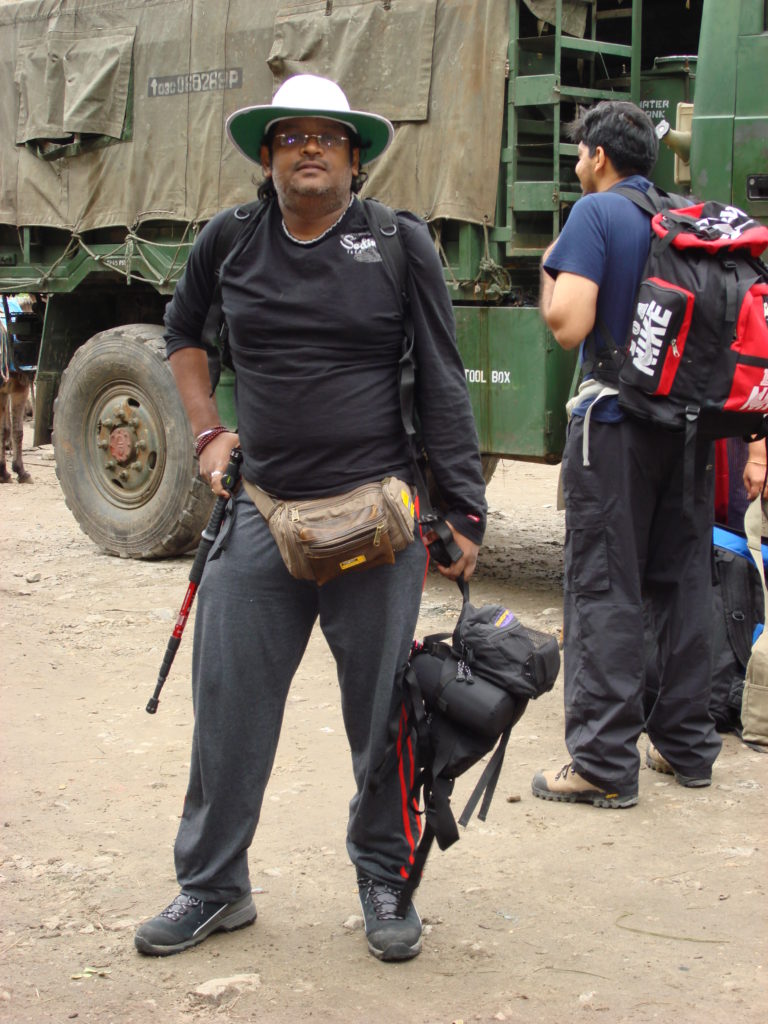
The route from Mangti to Buddhi is a picturesque one, with all the greenery with you one side and the roaring river Kali on the other side. The sound was so deafening at times. Walking through the paths laid out by cutting the rocks in the mountains wa a wonderful experience. Each step was to be laid with utmost caution as the stones were slippery. At certain points we had to walk through falls where at times with out a rain coat, would drench us completely.
Our first halt was Lakhanpur, where breakfast was served. I need not mention what breakfast, it was naturally poori and baaji. Lakhanpur to Malpa was around 5kms and it was 200PM when we reached Malpa for lunch. Malpa is the site of the tragic landslide.
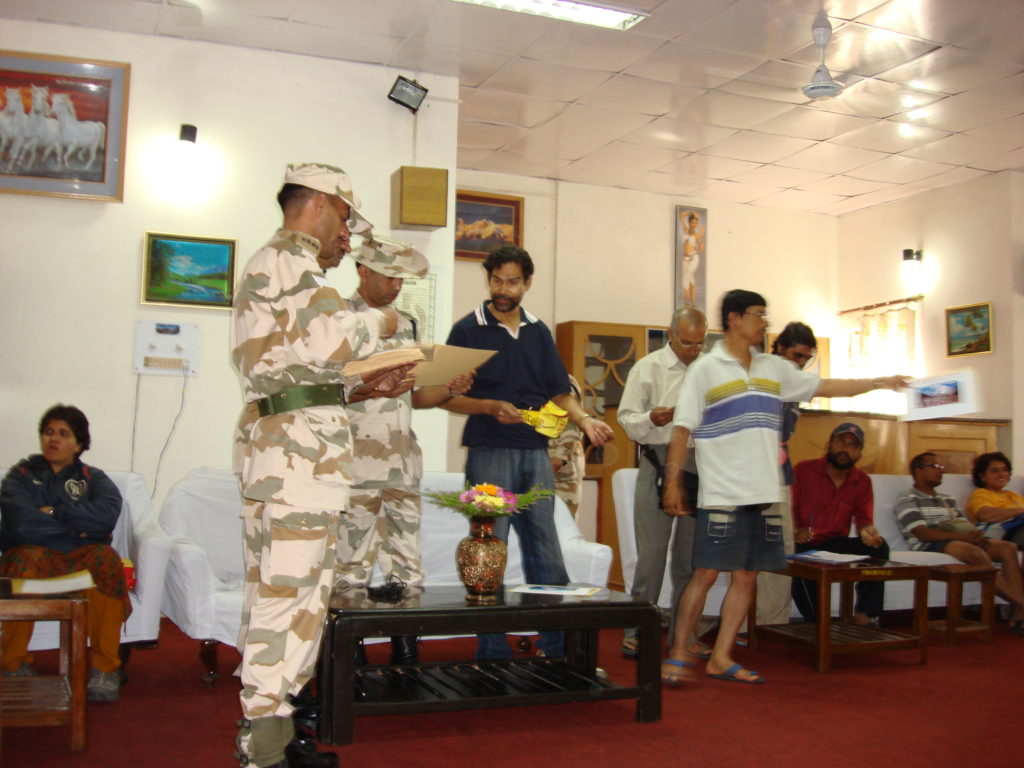
Earlier there used to be a halt at Malpa camp and one fateful night in 1998, a major landslide occurred and the whole batch of yatri were buried in the debris. The rubble still covers part of the camp. After lunch at Malpa, we had to walk to Buddhi (8990 ft), the camp where we had to halt for the night. On the way, the ITBP officials were there providing tea and snacks which was very refreshing. The last stretch of the trail is across a quaint bridge. The first day’s trek was 24 kms of which I had walked about 16kms the rest my pony took care. Opposite to the camp is an old flourmill run on hydel power, which supplies the local village with fine atta.
The camp at Buddhi was like a igloo sort of rooms which could accommodate around 8 to 12 people. A bedding and a quilt was provided. Soon after dinner I hit the bed.
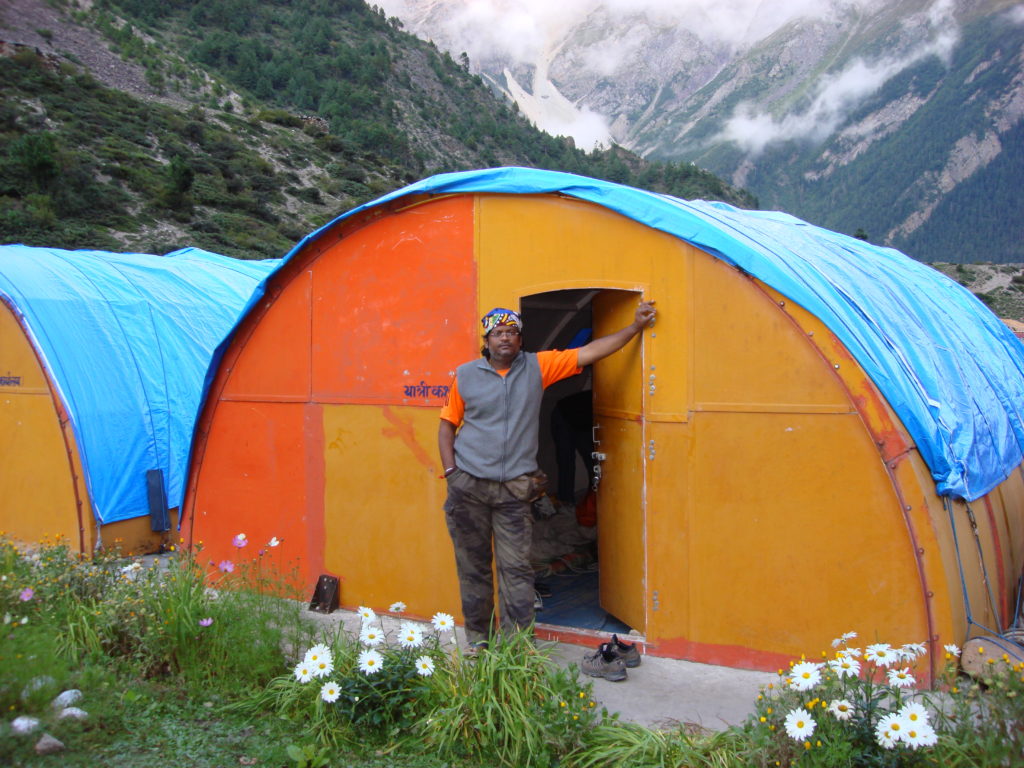
22nd August 2007
Morning was very fresh with cool breeze blowing and I could notice a change in the weather. We started of to Gunji a trek of 18kms. The first 5kms was a treacherous walk with a steep path. I had to get on a pony as my legs were giving away.
Once the 5kms was crossed, we were provided breakfast at Chialekh. Chialekh is a spectacular valley which is a home for rare mountain flowers like cobra flowers, Irises, May apple flowers, Kasturi kamal etc. Walking through the beautiful green meadow we reach Garbyang also know as the sinking village, a geolog ically blight ed ground with weak shale moorings; houses that were built high have now slid down to the level of the river. These houses have carved doors and newel posts. They say that these carvings were made by artisans from Kashmir, who used to stay in this village, when there was a flourishing trade between India and Tibet prior to the Chinese occupation.
After passing through a blanket of aromatic trees we see the confluence of the Kali and Tinker rivers with the Tinker hurtling away into Nepal. After crossing a bridge we first get into Gunji (11485 ft) village and then the camp. Entering into Gunji, we were given a warm welcome by the ITBP officials with a hot tea and snacks. Checking into our rooms we started to head to the satellite phone centre to call our people who may be anxious about our well being.
It must be around 1100PM, when all the people were fast asleep, I started to have breathlessness. I suddenly woke up from my sleep and saw myself sweating and panting for breath. I was sleeping with eight other people in a bunker and with the high altitude and people around I guess there was less oxygen and this made it all the more difficult. I had a weird thought that I had an attack and I started to cry thinking that it was my last few moments. Immediately I woke up Rajesh who was sleeping next to me and he took me out of the bunker and made me take a deep breath. The weather was very chill outside but it was really comfortable there than sleeping inside the bunker. I spent around half an hour outside and then went in and opened a small window so that air could circulate. After a while I felt better but not fully alright. It was a difficult night to pass.
23rd August 2007
In the morning I went to Dr. Bumb, and he immediately gave me some pills and taught a few breathing exercises. It gave me immense relief then. Later, I had a hot refreshing bath and immediately rushed to the ITBP Medical Examination. As I was late I was asked to stay for a while and it was here that I met Mr. Ashok, an ITBP Officer from Arunachal Pradesh, posted in Gunji for the yatra purpose. That our both names were same, he had became very close to me and also invited me to come to the Twang valley in Arunachal Pradesh. At the medical room, anxiety was ruling the roost, with very one trying to find out what the other person’s Blood Pressure rating was, as every one’s BP was high but for a few. When my turn came, I was examined by the doctors and my BP was found to 150/110, which was relatively high. We were asked to come back again in the evening. Most of the afternoon was spent sleeping and in the evening the doctors gave us some pills and asked us to report in the morning. Later most of the yatris went to the temple in the ITBP camp for some bhajans, but I and Siddharth took a stroll talking about our childhood pranks.
24th August 2007
The morning started with a BP test at ITBP camp and I was surprised to see that it showed 140/90-back to normal! The Doctor advised all of us to engage a pony uphill as the trek would be difficult and would cause some health hazards. Most of the yatris didn’t heed to it and went on with what they thought was good for them. From Gunji, the ITBP officials took over and guided us till the Lipulekh pass. The KMVN officials who were accompanying us were supposed to leave at Gunji, but however, we had a KMVN doctor, whose name I don’t remember came up to Navidhang, as his
major assignment seemed to charm the ladies in the group. Anyone who wanted to find the doctor first found out were the ladies were and then he would be there amidst them. The trek till Kalapani was around 9kms and it was one of the beautiful stretches to walk with the beautiful Kali River on one side and gorgeous mountains on the other side. While we were nearing Kalapani, we were shown the Vyas Cave on top of a mountain. Legend says that Vyas had done his penance in the cave. On the way you also find hot water springs and a hydel project over the river Kali which supplies power to the Kalapani camp. From Kalapani one can have a darshan of the Seshnag peak – a mountain peak which resembles the hood of a snake.
It was around 100PM when we reached Kalapani (11056 ft) and it was here that we had to give our passports for immigration check. In the evening our passports were returned. Kalapani is actually the birth place of the River Kali and here there is a small temple devoted to the Goddess Kali. The yatris spent the evening there singing bhajans. I and Siddarth as usual were out on a stroll.
25th Aug 2007
The day started with a 9km trek to Navidang (11056 ft). The place is so called because the mountain there resembles the “nabi” or the navel. As I was feeling breathlessness, I had to take a pony all the way. The stretch from Kalapani to Navidang is an uphill climb. As we proceed, we leave behind the river Kali and we could see lesser of vegetation on the way. At Navidang, one could have the darshan of the OM Parvat-A mountain which has the Sanskrit OM written on it in snow. As it was clouded, we couldn’t get a clear view. We were told that we have to get up at 300AM in the morning and start off by 400AM to Lipuleh pass, so early dinner was served and we retired early.
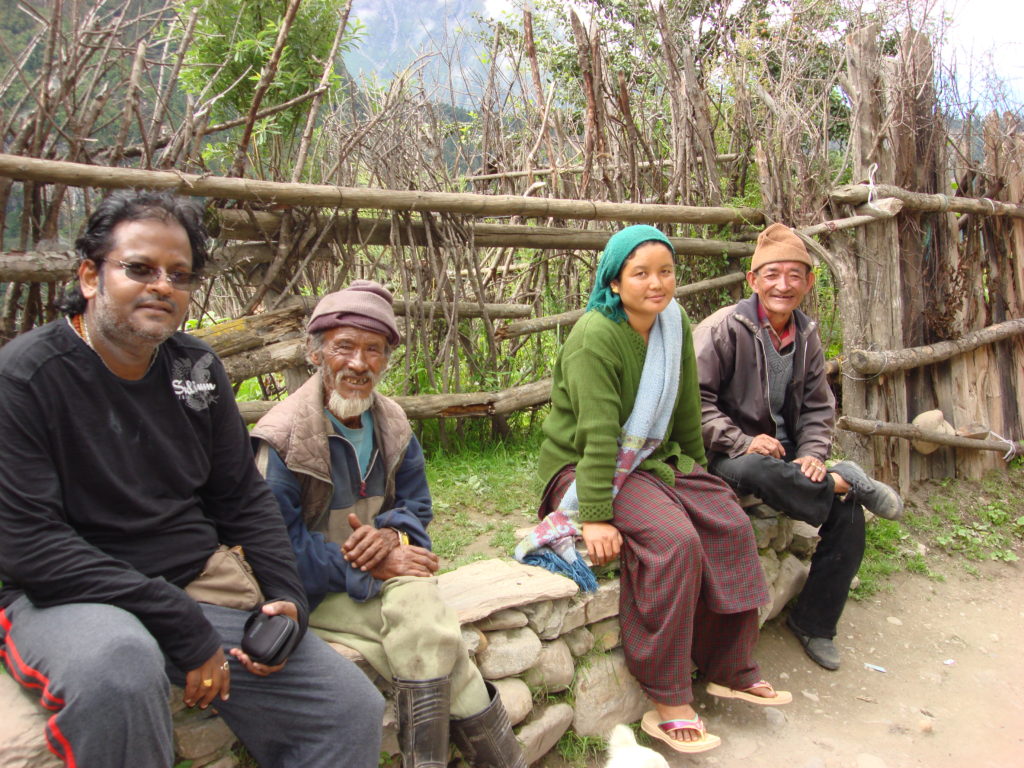
26th August 2007
The day started with a tea at 300AM and we had to get ready by 400AM. Those who were walking had to leave at 400AM and those by pony were asked to leave at 430AM. With the ITBP officials accompanying we started the trek at 430AM to Lipuleh pass (17500 ft). It was dark and we had to use the torch lights to find our way. The weather was wonderful but it was a treacherous walk for those who preferred to walk. As we kept going we could see that there was no vegetation and the land was barren. At a height of 16,500ft, the oxygen levels were low and each step was a difficult move. Smelling camphor helped to relieve spells of discomfort. The crossing of the pass is a finely-timed affair with the group passing
into Tibet meeting the group which is coming from Tibet after the Kailash yatra. The timing was perfect and we didn’t have to wait as the Chinese authorities were there by the time we reached. We paid for the pony and the porter and asked him to come back to pick us up on our return. From Lipuleh, we had to walk a distance of around 7km downhill. This was very difficult, because the downhill trek was telling on the thighs and the calf muscles. Immediately getting down from a height of 17,500ft gave me a severe headache. There was a bus ready to take us to Taklakot, a nearby town. Once in the bus, I took some pills and dozed off only to find me awake at Taklakot(13125 ft) .
Taklakot or Purang is an old trading town in Tibet. It has grown up to be a Chinese military town with scores of army people to be found at every nook and corner. The town has got broad roads and a line of shops and stores. At Taklakot, we were put up in the Purang Guest Home after our immigration and customs formalities were over. Earlier we had an apprehension about the Taklakot toilet facilities. People who had been on this yatra before used to say that the toilets were the worst of its kind with pits of 10ft depth which remained unclean. Thank God, the authorities have built a new guest house with western toilets after continuous pressure from the Indian side. The town follows Beijing Standard Time which is 21/2 hours ahead of us though, the sunrise and sunset happens according to Indian time. This gives a different feeling as we were served dinner when the sun is bright out and breakfast immediately after sun rise. I and Siddharth, made a few purchases as things were cheap there and retired back to our room.

27th August 2007
We had nothing to do and we had to stay in Taklakot for the day. I, Siddharth, Rajesh, and Kalpesh visited a Nepali restaurant and had some rotis and aalu curry as the food given at the rest house was horrible. There was some rice and a salad with a dal which didn’t appeal even to a hungry stomach. Breakfast was still worse with dried bread and soft bread with some fryums and tea.
In the evening, the LO had called for a meeting and asked us as to where do we want to go first, whether the Kailash or the Manasarovar. Our mini group of Siddharth, Rajesh and I, preferred to go to the Manasarovar first and we gave our names accordingly and also our requirements of pony and porter. The Bangloreans had opted for the Kailash with the LO joining them. The Mangaloreans were with us with Dinesh as the acting LO. We were introduced to our guide Mr.Tampa, a short and a stocky guy who insisted that everybody takes a pony due to the high altitude. As all the Mangaloreans preferred to walk along with a few others there were hardly 4 or 5 people who
took to pony and this infuriated our little Tampa who was all the way complaining and cursing.
28th August 2007
After breakfast we boarded the bus which was waiting for us to take to Qihu a place by the Manasarovar Lake. We were a batch of 27 people to Manasarovar and the rest for Kailash. The route was through a dusty road with no vegetation at sight but only sand all the way. Our first halt was the Rakshas Tal (14815 ft). It was a wonderful and a spectacular lake on the left side. Looking at the lake, I was spellbound. It was as though I was standing in front of a painting and in fact feeling to be a part of the painting. A mere look at the lake was worth the pain taken in coming from India. This Rakshas Tal or the Ravan Hrid is at a height of 4515m and receives surplus water from the Manasarovar which is on the right side. This lake gives birth to the Sutlej River. Both Manasarovar and Rakshas Tal are connected by a natural channel called Ganga Chhu. Unlike Manasarovar, this lake is not revered by the Hindus. While Manasarovar is likened to the sun and light, Rakshas Tal is compared to the moon and the darkness of night. IT is believed that Ravana is supposed to have meditated on the shores of Rakshas Tal to seek Lord Shiva’s favour. It is from here that we get to see the first view of the mount Kailash.

By the time we reached Qihu it was 300PM Chinese time. There were many land cruisers with pilgrims from the Nepal side. We had our lunch prepared by another pilgrimage party from tamilnadu. I enjoyed the rasam especially as it was nearly a month since I tasted south Indian food. After lunch we waited for some time for the clouds to clear and get some sunshine. Once the weather was warm I proceeded to take a dip in the Manasarovar Lake (14860 ft).
Between Mt. Kailash and Gurla Mandhata is situated the holy Manasarovar Lake., the lake created from the mind of Brahma. The lake changes colour and mood with the passing hours and seasons: Placid now, tempestuous the next. The reflection of the sun, the clouds, the stars and even Kailash, keeps the beholder spellbound.
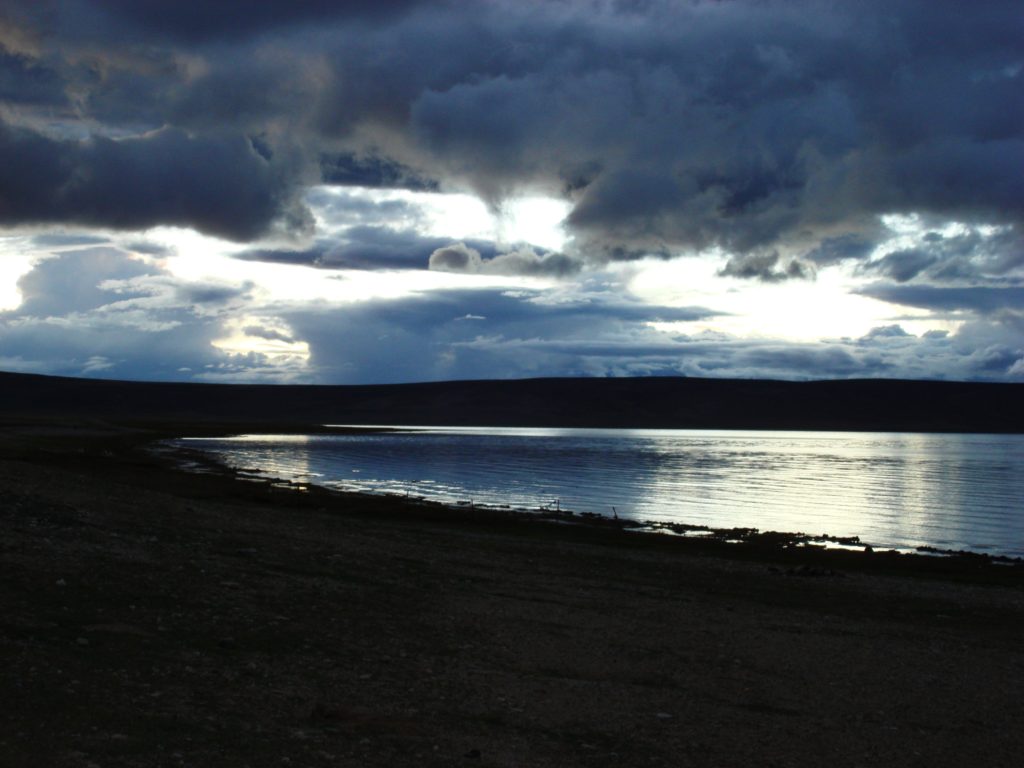
The lake is large, being 88kms in circumference and with a maximum depth of 300ft. Its fascinating variety and beauty captures the heart and imagination of the viewers. The water of the lake can be freezing at certain times of the day and during certain seasons and pleasantly warm at others.
It was a wonderful experience as the water was too cold and a dip made me quite refreshing. It was as though I got a new lease of life. In the evening we took a walk to the ancient Gompa monastery which was on top of a hill and the rest of the evening was spent taking pictures of the lake. One of the pictures was the rainbow over the Manasarovar. It was a wonderful view, which I bet, I will never be able to see such a beauty of this great magnitude in any of the lakes.
Siddharth who had come with a high end digital camera was busy at the lake fixing his camera to a tripod and waiting for a clear sky to take pictures. It was at that moment that he recorded a flash of light at the other end of the lake which was a wonderful view. First it was thought that it was the angels coming down to have a bath at the Manasarovar, but later we concluded that it could be a light from a land cruiser moving at the other side of the lake. There was this myth that the angels from the heavens come down to take a dip at the Manasarovar and to view this most of the pilgrims were awake to see the phenomenon and some were even clever enough to hide behind a door to see so that the angels don’t notice them. Now that Siddharth had said about his video, the next day each one came up with his or her own story about the angels bathing to prove that they were also the gifted ones to have this vision. One lady from Gujarat went to the extent of saying that 4 stars came down from the sky took a bath and went towards mount Kailash!!
29th August 2007
Going to the toilet was a horrifying experience. The toilets as I mentioned earlier were primitive ones with pits of about 10ft depth and full of faeces and separated by a small mud partition with no privacy. The smell emanating made it one of the worst toilet experiences. From the next day I decided to go out in the open. After a quick breakfast, we boarded the bus to Qugu (14765ft). On the way we stopped by a small Tibetan town
called Hore (15100ft). Reaching Qugu, we had a dip at the Manasarovar and had a hot bisebele bath for lunch made by the Mangalorean people.
30th August 2007
The next day too we had to stay at Qugu. It was raining in the morning and I woke up with a severe backache as the cot allotted to me wasn’t good. Once the rain stopped, I took a dip in the Manasarovar for the third time. It was here that I gave tharpan to my deceased father and ancestors.Mr. Shukla, a Brahmin from Gujarat, performed the puja. It was here that we got a clear view of Mount Kailash for one hour as the sky was clear. There wasn’t much thing to do and we went to the nearby Gompa monastery and then again to the lake to take pictures.
31st August 2007
Morning after breakfast we proceeded to Qihu, the place we first halted. With this the parikrama or the circumambulation of the lake was complete. On the way we got down at the banks of the Manasarovar and searched for stones with the inscription of OM. It is a practise to collect stones from the banks of Manasarovar with the OM inscription as such stones are in abundance there. In the afternoon, there was a heated argument regarding porter and pony with Tampa, our guide insisting that everyone take a pony during Kailash parikrama and with Dinesh leaving it to the individual decision. At last 13 people decided to take a pony and the rest 14 decided to walk.
1st September 2007
Morning we left for Darchan (17000ft) after the usual breakfast. At Darchan, we met the earlier group which had gone for the Kailash Parikrama. Once we reached Darchan, they were ready to go for the Manasarovar parikrama. The bus which left us took them for their journey. On discussion with the group we found out that the weather was not good and of the 20 people, who had gone for the Kailash parikrama, only 6 were able to complete it. Some of the people in the Bangalore group faced health problems and the whole group returned back without doing the parikrama.
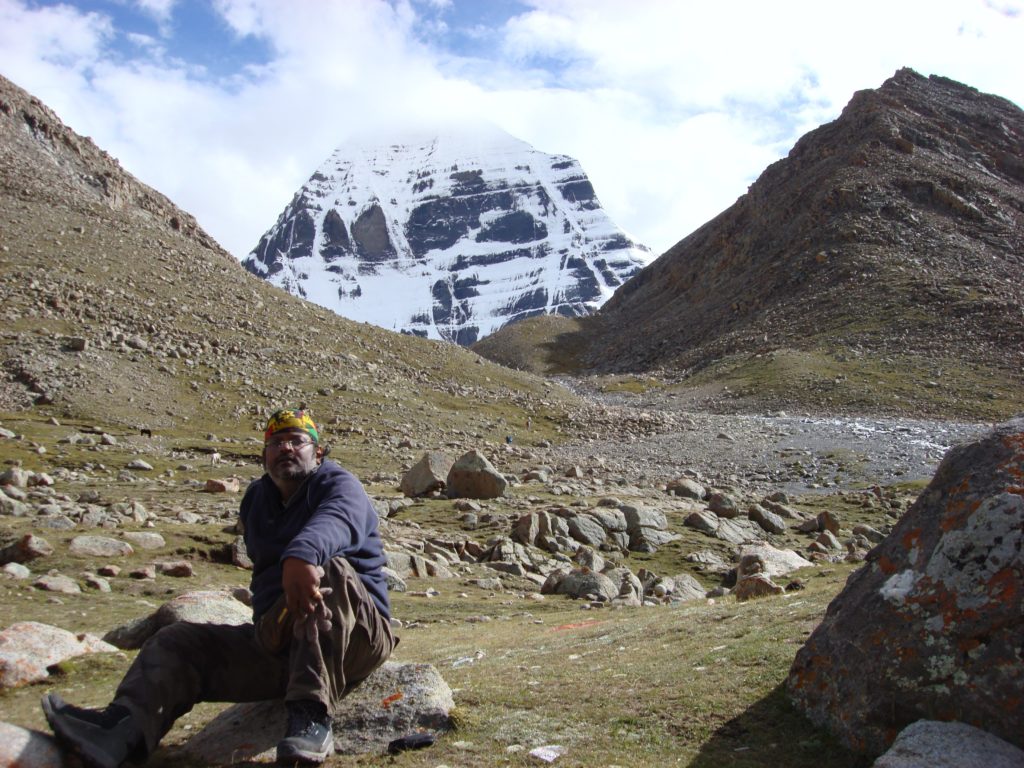
Once we were in our rooms we were mobbed by the Tibetan traders who were mostly women who brought with them curios for sale. We made some purchases and then relaxed in our rooms. From our rest house we had a different view of the mount Kailash and we took some photographs here. In the evening we packed our bags and took only those which were necessary for the trip and packed the rest and left it in the cloak room.
2nd September 2007
Morning at about 830AM a boarded a truck which was ready to take us to Yamadwar. It was a 30 minute drive to Yamadwar, a place believed to be the abode of Yama the God of death. The Yamadwar has a small entry point with two mounds on either side with horns of the yaks and tablets with Buddhist inscriptions placed on them. We had to make three circumambulation of the entire structure and then enter through the Yamadwar. A kilometre from there we find the porters and the pony men waiting for us. It is a system of drawing from the lots which decides as to which pony/porter is to be allotted to which yatri. I got Kanga as my pony man and he was very considerate. Little bit of trekking and little bit of pony riding took me to Dherapuk, which is 14kms from Yamadwar. On the way we entered the La Chu valley or the valley of the river Gods. Along the way, magnificent rock cliffs tower around us, with streams and waterfalls flowing through some of them. Some of the rocks have Buddhist mantras inscribed on them. On reaching Dherapuk, we retired to our dingy rooms. The literal meaning of Dherapuk means Cave of the female yak’s horns. From Dherapuk we can get a clear and a magnificent view of Mount Kailash.
This is the closest and clearest view one can get of mount Kailash. The spectacular view of the Kailash makes even an atheist to raise his hands and thank nature for providing such a wonderful feast to his eyes.
Mount Kailash is regarded by Hindus as the centre of the spiritual world, and its peak, which is always snow-clad, stands at an altitude of 22,028 ft. The mountain is said to have holy vibrations and permission to climb it is not granted on the grounds that it is a religious place for Hindus, Buddhist, Jains and the followers of the Bon religion. All pilgrims can do is circumambulate it. It is believed that one parikrama washes away your past sins, while 108 parikrama could be your ticket to nirvana. We took as many pictures as possible of the mount Kailash and it was here that Siddharth and Rajesh went
further a distance of 4kms to Charansparsh, the foothill of Kailash and got fully drenched in the rain on their return. It took nearly 4 hours for them to come back to normalcy in that chilly weather. It was here for the first time did I see a snowfall.
3rd September 2007
Starting at 600AM in the morning it was treacherous ride on the pony with the oxygen levels getting lesser and lesser as we gained height. There was snow on the way with a little of an icicle fall. After a ride of 3 hours we reached Dolma pass, the highest point of the circumambulation. As a comparison, at over 19,000 ft, the altitude of the base camp to Everest is only around 17,000 ft. Passing the Dolma remains a test of determination and faith as chilled winds, rare temperature and even the occasional blizzards are known to strike without warning. You see a stretch of discarded clothing, all strewn by pilgrims on the way. Also at Dolma Pass is a huge stone memorial of Goddess Dolma, known by Hindus as Tara Devi. Offering our prayers there, we immediately moved as breathing was becoming difficult.
There is one thing which I noticed here. I saw a Buddhist monk, doing the parikrama by kneeling down and prostrating. He was doing this throughout instead of walking. It was astonishing, the faith people have and the amount of pain they were ready to bear when it comes to worshipping. A half a kilometre down, we could see the Gaurikund.
The emerald green water of the lake amidst the pristine surroundings was a visual delight. The lake, at 18,400ft, is one of the highest in the world. A small pond, where the Hindus believe that goddess Parvati had taken bath. The water of that pond is believed to have curative powers and people take back some water from the lake by paying 10 yuans to the guide, who organises the collecting of water. A trek down of 5kms brings us to the foothill where a small shop caters to the thirst of the pilgrims. One more kilometre, and the ponies are ready again to take us to Zongzerbu. On the way, there was a heavy rain and I got completely drenched in spite of my raincoat. Luckily there was a small Tibetan rest house where I had tea and moved. By evening we were at Zongzerbu and I started shivering with chill as I was wet. It took a couple of hours for me to get back to normalcy.
4th September 2007
From Zongzerbu, I decided to walk the stretch with Siddharth along. After a trek of 15kms we reached a place where a bus was waiting to take us to Darchen. It was here that our guide Tampa told that we have to rush to Taklakot as two of the yatris in the other group were critically ill. I started speculating as to who could be those two people. Tensed up we took the bus and reached Darchen. At Darchen we got the news from Dinesh that Ravi Prakash has expired of Pulmonary Oedema and Dr.Bham was seriously ill. We were told that Ravi had severe cold and complained of breathlessness at Qihu and when rushed to Taklakot, he couldn’t survive the treatment. It was a shock to me as I never thought that it would be Ravi, because Ravi was a healthy person of 41 years, he had walked all the way and never used a pony.
At Darchen we took our luggage from the cloak room and left for Taklakot. There was complete silence in the bus as people were yet to come in terms to the realty of the death which occurred. On the way at Rakshas Tal we had a last glimpse of the Mount Kailash.
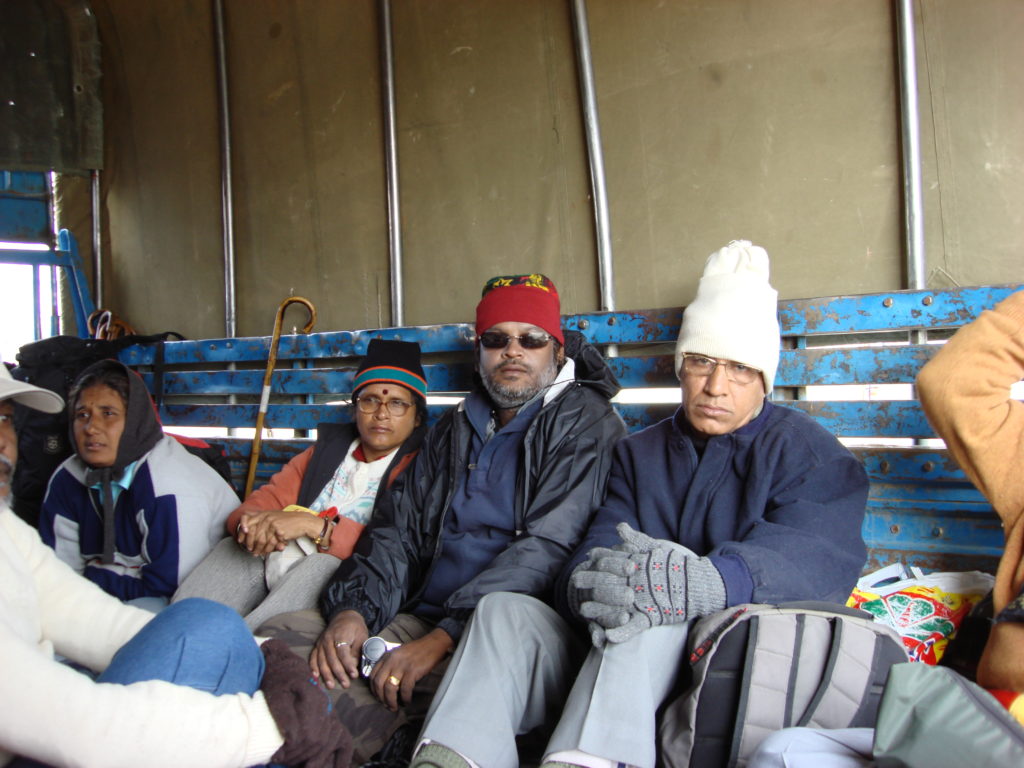
The bus stopped for a while and we took pictures and left for Taklakot. On reaching Taklakot, we were met by a few yatris from the other group and some from our bus left with them for the funeral of Ravi Prakash. One consolation was that Dr.Bham, who was supposed to be seriously ill, was hale and healthy and it was a urinary track infection which he suffered from. He left the next day to India for treatment at the Gunji hospital. Another sad news was that Krishna Hande, a yatri from Bangalore who was an active and humorous person, had lost his father and he had to rush back to India along with Dr.Bham.
5th September & 6th September 2007
Morning we started of to Khojarnath monastery which is about an hour and a half drive from Taklakot. Situated on the left bank of Karnali River, Khojarnath is a beautiful village with a Buddhist Monastery which houses the famous statues of Lord Rama, Laxman and Sita made of pure silver. This place is close to the Nepal-Tibet border and is about 25kms from Taklakot. After the visit we got back to our rooms and relaxed. In the evenings Siddharth and I would visit a local Chinese restaurant and have Chicken in soup a wonderful dish with all the herbs in it.
7th September 2007
This was the day every yatri was looking forward-the day of return to India. There was the usual immigration check and we started of at 600AM to Lipuleh pass. It was an hour drive and when we reached there, there were ponies ready to pick us up to the Lipuleh pass. With the snow covered, Lipuleh pass was a wonderful scene to view. We crossed over with the pilgrims of the 16th Batch to Kailash, and at Lipuleh we were received by our pony wala and porter who gave us a warm hug of welcome. Stepping in our motherland was such a wonderful feeling with no words to express. It was as though I had landed in safe hands and that I was being taken care of in each and every step of mine. In China, the fear of death had always haunted me as I felt that anything could happen and that no one was there for me. In India, the fear was completely gone and the fragrance in the air I breathed then, is still there lingering in my mind. Yes home is sweet. It was a fast trek downhill and in a couple of hours I reached Navidang. Before the Navidang camp is the remains of a helicopter which crashed somewhere in the month of March, I was told. On reaching Navidang, nature had something precious to offer. I had a clear view of the OM Parvat.
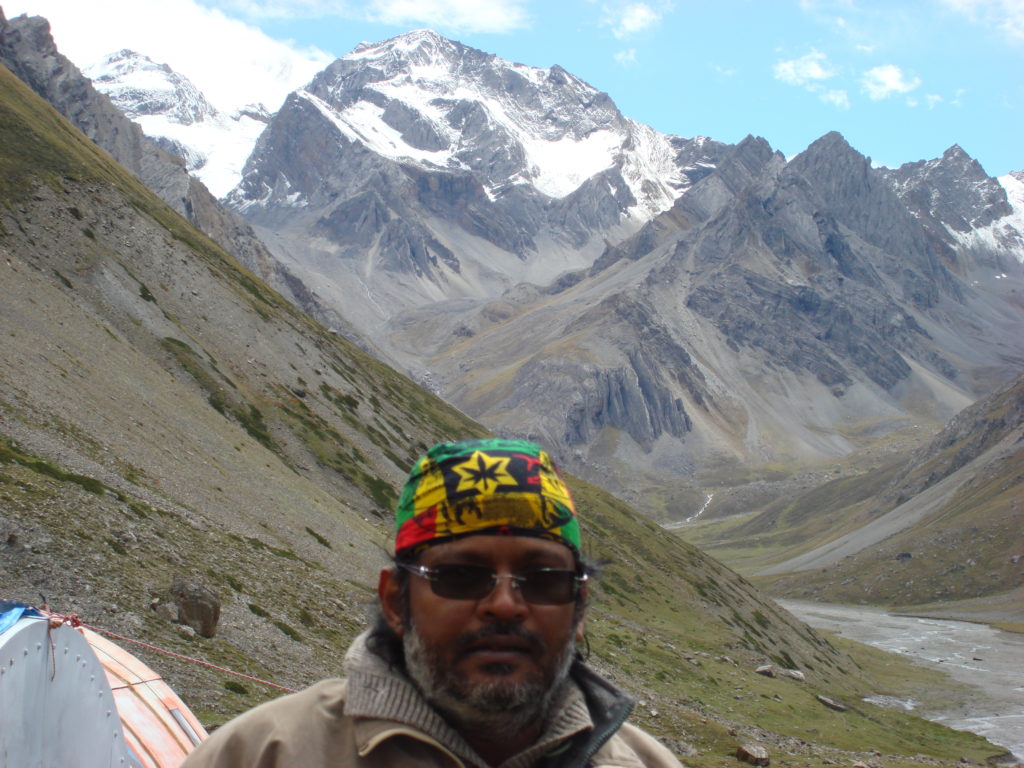
I felt I was blessed on seeing the OM. A number of photographs were taken and after lunch, we proceeded to Kalapani. At Kalapani, apart from the immigration formalities, our baggage was also weighed by the KMVN officials and the charges for the extra baggage were borne from the collective fund.
In the evening we were invited for a Bara khanna by the ITBP officers. After prayers at the Kali temple, we had a wonderful dinner with the officers.
8th September 2007
The next day trek was to Gunji. After a walk of 4kms we assembled by the riverside, where we paid homage to Ravi Prakash and his ashes was mixed in the river after the prayers. We walked a further 5kms and reached Gunji. It
was the last place where we got our luggage and after this we were told that we could access our baggage only at Dharchula. By Here too we enjoyed the dinner hosted ITBP officials.
9th September 2007
Morning we had a beautiful darshan of the Annapurna range. We started of to Buddhi after breakfast. The first 15kms were quite easy to trek but the last 4kms downhill from Chialekh was the most difficult walk. The route being steep made the trek difficult. It was at Chialekh that we got the news that there was a heavy landslide at Tawaghat, where at least 4 people were killed and that the roads were blocked for vehicular traffic. Putting the burden on God, we walked downhill and on reaching the Buddhi camp everyone fell down like pins. A little stretching exercise made us come back to normalcy.
10th September 2007
The trek to Buddhi to Mangti nala is around 24kms and we had to leave early as by lunch we were scheduled to reach Mangti. On reaching Mangti food was provided at a small dingy shop and here we had to wait for a couple of hours for the jeeps to pick us. There was a problem in the arrangement of the transport and some of the yatris picked up a fight with the KVMN official with Rajesh playing a lead role. Not that fluent in Hindi I had to just sit and watch the fun. As and when a jeep came, people started to board it, first the old and the aged followed by the women and then us. In the mean time, I started interacting with the local people and they seemed to be so innocent. I took a picture with them before I left. We had to go up to Tawaghat, where a huge landslide had occurred. The landslide was so huge that a mountain of rocks and rubble had fallen on the road and went down to the river Kali and blocked 3/4th of the river. We had to climb the rocks and reach the other side where a bus was waiting to pick us back to Dharchula. At Dharchula, Siddharth wanted to go on a private taxi to Delhi and later had to drop the idea as me and Rajesh felt it was better to go in the KVMN bus.
11th September 2007
From Dharchula we left in two buses to Meerthi, where we had a meeting with the ITBP officers who gave us a copy of the group photograph as souvenir. From Meerthi we reached Jageshwar. Jageshwar is a small temple town, which boasts of temples built during the Gupta era in around 500AD. The temples are an architectural splendour.
12th September 2007
Morning we got up at 300AM, got ready and went to the Shiva temple at 400AM. The linga at the temple is considered by the locals as a jyotirlinga, even though it doesn’t fall under the list of the 12 jyotirlingas. We drove en route Almora, where we had our breakfast and reached Katgodham, where me and Siddharth had a non vegetarian lunch at a Punjabi Dhaba and then changed to an AC coach which took us to New Delhi. It was around 830PM when we reached Gujarat Samaj.
The month long yatra at last came to an end. Everybody was eager taking the contact details of others. Some people left immediately and some left the next day and I was again alone on my way back home but with memories which I could relish for the days to come. There were moments of fun in the group when I started mimicking most of the people, especially the way Ravi used to walk; the way Bhoi, Aswini, B.C. Kumar, Sandhya, Archana Tayal used to talk; the gait of Mr. Seth and so on.
Siddharth, I and Rajesh also had the fun in giving nicknames to some of the yatris namely,
• Mr. Bhoi – Bajrangbal – as he walked like hanuman and in fact looked like him in his monkey cap;
• Mr. Seth – Jambavanth – as he was always with Bajrangbal;
• Mrs. Sandhya – Nirma the Dhobi – as she never lost the opportunity to wash clothes whenever there was water around;
• Dr. Bham – smeagul, of the Lord of the Rings fame, as he looked like that;
• Mrs. Suchitra – the self proclaimed Angelina Jolie;
• Mr. Jaani bhai & Mr. Mahesh – Nakula and Sahadev;
• Mr. Daxesh Patel – The Biogas expert, for his farts;
• Miss. Bindu – Rolling stones;
• Mrs. Yojana – The Mummy Returns and so on.
It was a month long journey where I was left in the wild with people with whom I don’t have any acquaintances but at the end I had developed friendship with a few people especially, Siddharth, who shares most of the values I have for life. This journey gave me the opportunity to meet people of different mind set especially, Dharampal Singh, who took the pony at Mount Kailash and refused to pay the money to Dinesh who had earlier paid for it; Rajesh who had a deep love for Dharampal Singh for reasons best known to him. He had given him his expensive goggles; his thermal wear; his addidas shoes for him to use and also paid the pony money to Dinesh. I am still unable to find out the reason for this altruism; Shukla, who always tries to find fault with the Mr. Bhandari the Liason Officer and ends up in some trouble; Mrs. Shukla, who on coming to know that Siddharth had taken a video of some light in the Manasarovar, came out with a new version the next day, of 4 stars taking bath in the lake and then proceeding to Kailash; Jaani Bhai who proclaims that Shiva had given darshan to him along with his wife Parvati and two children Ganesh and Kartikeya; Kalpesh, a well read software professional, who was reluctant to take photographs at the Rakshas Tal, a beautiful lake as it is believed to emanate negative energy; a study of these people would be a psychologist’s delight. Well all said and done, they had their own reasons for their ideas and may be I should stand in their shoes to know why.
There were certain incidents which make me laugh with a mere thought of it. The land cruiser, which honked at my back when I had gone to take a dump in the open in Qugu; the way Jambavanth went round and round in the pony before he fell down; the idea to make a bulb glow out of bio-gas in the night as Daxesh was farting; the bhajans at Kalapani where, Jambavanth gave a soul rendering one which left most of the people sleepy; so on and so forth.
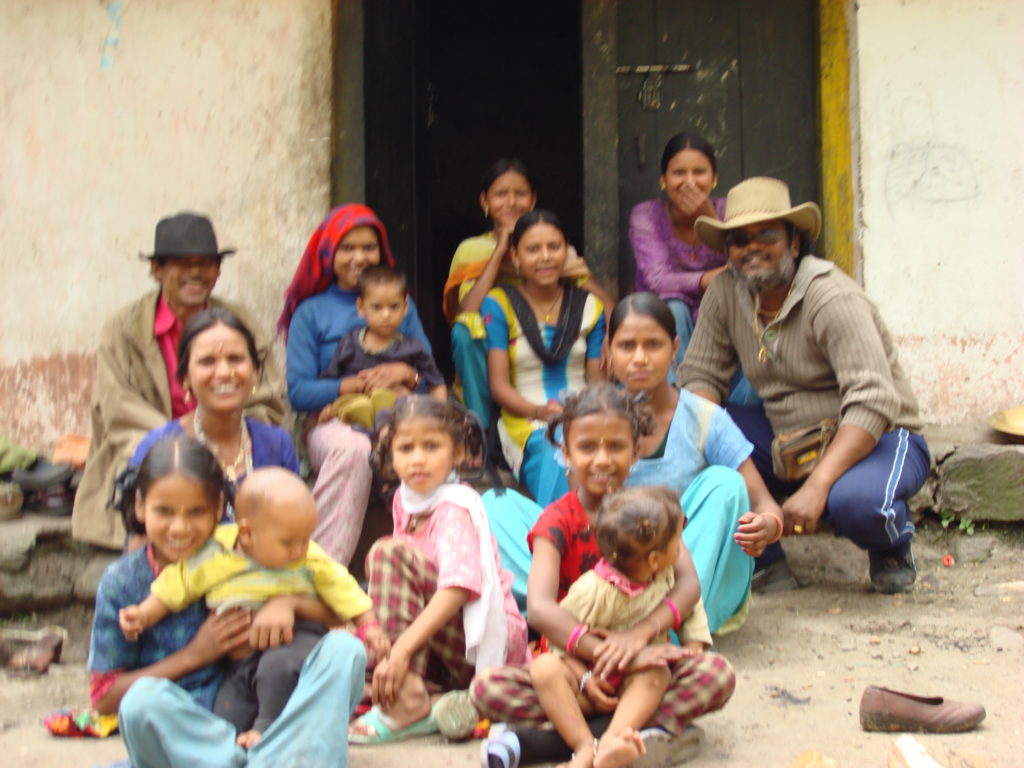
Well about the journey as a whole, it is a must to undertake for it gives us an opportunity to interact with nature where we learn to be submissive to it. Nature unleashes before you in great magnitude, the pristine beauty of itself and above all it gives an opportunity to live with your own self. Much care also has to be taken as it is not another run of the mill journey. It puts you at various altitudes and temperatures and at times the nature may be unkind towards you and it is only perseverance which helps you to complete the journey successfully. A sound body and a sound mind are the two things which are mandatory for the trek.
As mentioned above, the tedious uphill trek and a steep downhill descent; the low oxygen levels; the cramping of 8-12 people in one bunker which suffocates; the chill weather; the cold dip; the tanning of the skin, all these really puts the body to severe task and one who is ready to take the challenge is the one destined to have the divine vision and experience.
Kailash-Manasarovar – My Experience

ASHOKAN SRINIVASAN